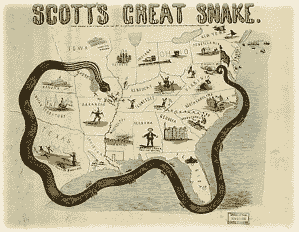Aims, Strategies and Prospects
Stated in simple terms, the aim of the Confederacy was to sustain its independence while the Union was intent upon restoring the Union. One side had defensive aims with time on its side; the other needed to take the war directly to its enemy.
 The Northern strategy was originally conceived by General Winfield Scott who, although elderly and in poor health, was able to devise what was called the Anaconda Plan, named after the constricting South American snake. The plan envisioned the following, to:
The Northern strategy was originally conceived by General Winfield Scott who, although elderly and in poor health, was able to devise what was called the Anaconda Plan, named after the constricting South American snake. The plan envisioned the following, to:
- Split the Confederacy by sending army and navy forces down the Mississippi River and occupy strategic points: Beginning with U.S. Grant’s victories at Forts Henry and Donelson in February 1862. The Civil War in the West continued with New Orleans, guardian of the mouth of the Mississippi, falling to Union forces in April. Both sides suffered heavy casualties at Shiloh. An indecisive encounter at Perryville was followed by a Union victory at Murfreesboro, ending a Confederate push into Kentucky. The West was sealed off from the remainder of the Confederacy following the Union victory at Vicksburg in July 1863. Northern forces began a thrust into enemy territory in the Chattanooga Campaign and later in the Atlanta Campaign. William T. Sherman’s “March to the Sea” ended with the occupation of Savannah in late 1864.
- Starve the Confederacy by blockading the Southern port cities, making it impossible for them to receive European support or goods: A blockade of the South – an effort to deny supplies from and trade with outside sources; it appeared for a while that Britain was receptive to Confederate aims in the construction of the Alabama, which preyed upon Union shipping; France toyed with recognition of the South, but contented itself with an invasion of Mexico.
- Invade the South and capture the confederate capital, Richmond, Virginia: A campaign to capture Richmond, the Confederate capital, required nearly the entire course of the war to accomplish, due in large part to Robert E. Lee`s skillful maneuvers. The First Battle of Bull Run showed that the conflict would not be won easily. In the spring of 1862, Union General George B. McClellan opened a lackluster Peninsular Campaign, which was intended to take Richmond. A Confederate victory at the Second Battle of Bull Run opened the door to an invasion into Maryland. A long-awaited Union victory occurred at Antietam, providing a morale boost for the North and an opportunity for Lincoln to announce his Emancipation Proclamation. Fortunes again turned in favor of the South in a stunning victory at Fredericksburg. In 1863 the Confederates won a costly victory at Chancellorsville, but their northward push ended at Gettysburg in July. A war of attrition took place in the Wilderness Campaign. The Siege of Petersburg and the fall of Richmond occurred in early April 1865. Lee surrendered on April 9. Less than a week later President Lincoln was assassinated.
The
Southern Strategy has often been described as offensive-defensive, meaning that the emphasis would be on defending Southern territory but offensive opportunities would be taken when presented. Confederate armies were split into state or regional contingents, in part in anticipation of potential invasion points, but also because of the political reality of allowing soldiers to remain under the control of local commanders or state governors. This spreading of troop strength risked the possibility of breakthroughs by the opposition. Later in the war the South would turn to a war of attrition, in the hopes that their entrenched forces could drag out the conflict until the Union withdrew in exhaustion. Both sides eventually resorted to the
draft to fill their ranks.
Many of the material advantages in the looming conflict rested with the North. The South, however, had less tangible advantages and remembered America’s surprising victory over a superior world power in the War for Independence. A summary of the two sides’ prospects follows:
|
|
North
|
South
|
|
Population
|
22 million
|
9 million
(including 3.5 million slaves)
|
|
Railroad mileage
|
20,000 miles of track
|
9,000 miles of track
|
|
Supply and communication lines
|
Long and exposed to hostile forces
|
Short interior lines—defending home territory
|
|
Gold reserves
|
$56 million
|
$27 million
|
|
Industry
|
Converted to war production
|
Little existed
|
|
Shipping
|
Merchant marine traded worldwide
|
Little; had depended on North
|
|
Theater of war
|
Enemy territory; unfamiliar
|
Home territory; well known
|
|
Military leadership
|
Some experienced officers
|
Many experienced officers from Mexican War
|
|
Military readiness of soldiers
|
Disproportionate number of immigrants; hiring of
substitutes common; desertion
|
Young men accustomed to outdoor life, guns, horses; desertion
also a problem
|
|
Public support
|
Public opinion sharply divided; Copperheads, draft riots,
bounty jumpers
|
Generally supportive of war effort, but tax evasion and
profiteering common
|
 The Northern strategy was originally conceived by General Winfield Scott who, although elderly and in poor health, was able to devise what was called the Anaconda Plan, named after the constricting South American snake. The plan envisioned the following, to:
The Northern strategy was originally conceived by General Winfield Scott who, although elderly and in poor health, was able to devise what was called the Anaconda Plan, named after the constricting South American snake. The plan envisioned the following, to: